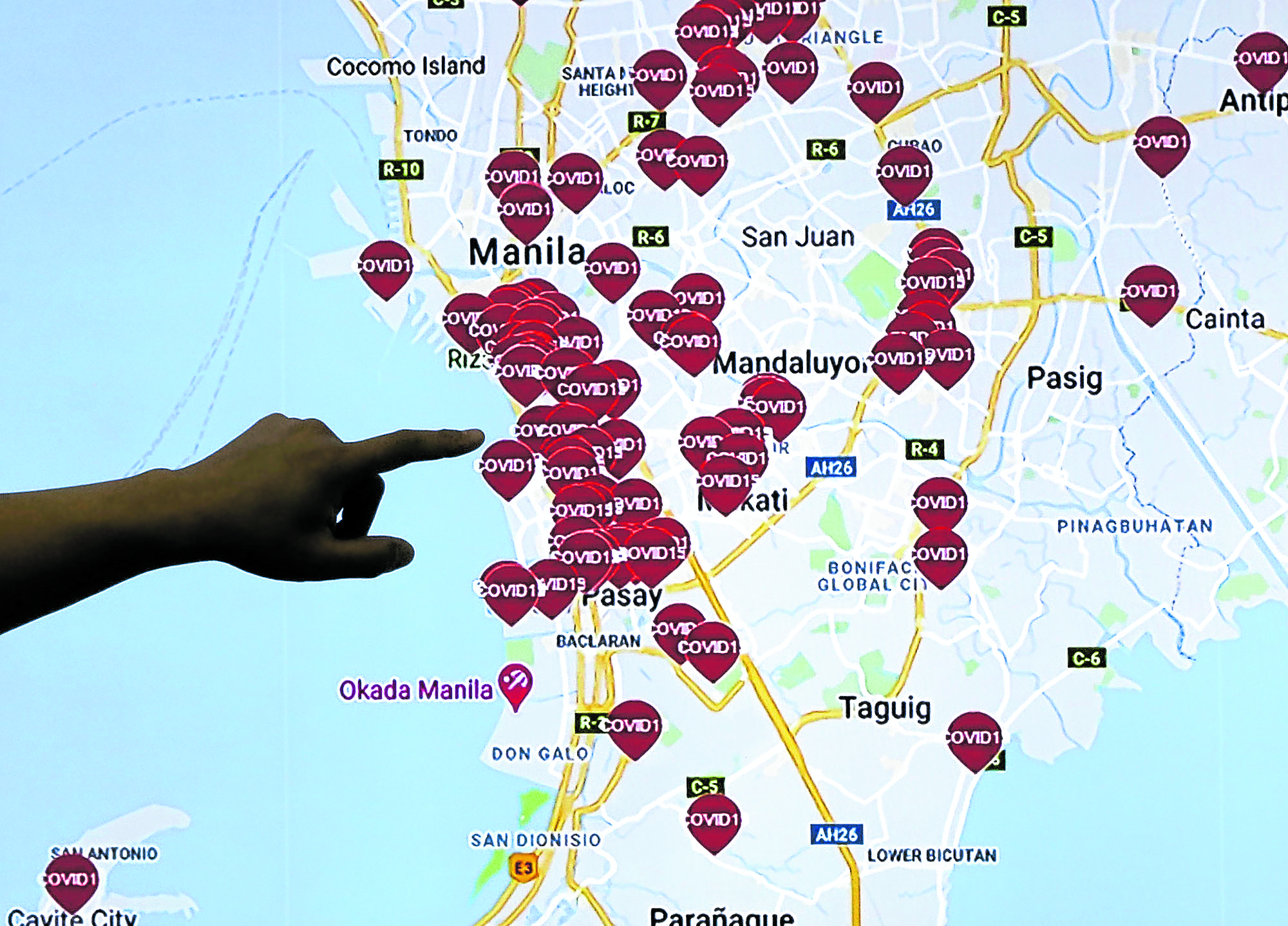DOH: COVID bed occupancy in Metro now ‘alarming’

COVID-19 COMMAND CENTER A large computer monitor at the command center of PureForce and Rescue Operation Corp. in Santa Cruz, Manila, shows the COVID-19 hot spots in the Philippines as of Thursday. The private company, which has a tie-in with the Department of the Interior and Local Government 911, tracks cases and helps patients contact the government’s One Hospital Command Center for referral to hospitals with available COVID-19 beds. Shown in the picture above is a map indicating the concentrations of coronavirus infections in Metro Manila. —RICHARD A. REYES
The Department of Health (DOH) on Thursday said the 64 percent occupancy of intensive-care beds for COVID-19 in Metro Manila hospitals was “alarming” and the government may refer patients to hospitals in Central and Southern Luzon if the hospital space availability in the metropolis worsened.
Health Undersecretary Leopoldo Vega said it was a matter of concern that 47 percent of new COVID-19 cases were recorded in Metro Manila, and he recommended that the public take action to help curb the increase in coronavirus infections.
According to Vega, some 52 percent of 7,000 COVID-19 isolation and ward beds in Metro Manila were now occupied, along with 64 percent of 679 intensive-care beds.
“The numbers show moderate risk. It’s alarming. We can be very comfortable if it’s low risk, below 30 percent. But this is already [more than] 60 percent, so alarming. [W]e need to do something. We have to do the appropriate response [to help] hospitals, both public and private, in Metro Manila,” Vega said at a press briefing in Malacañang.
Double masks
To help hospitals cope with the situation, people should improve their practice of health standards, Vega said.
Article continues after this advertisementHe cited the use of double masks as an example of a measure to boost protection against the coronavirus.
Article continues after this advertisementVega said he brought up the use of double masks because the transmission of the coronavirus was getting out of hand.
The people, he said, can help by guarding against infection, like avoiding crowded places, limiting their interactions with other people, and stay in well-ventilated places if they are in groups.
“Individual behavior has to be enhanced [by] changing your mindset of doing things,” Vega said.
Major public and private hospitals in Manila, Makati and Taguig are already between the moderate and high-risk categories due to an increase in COVID-19 patients, he said.
“We are keeping an eye on this because we could help in terms of coordinated care and referrals to hospitals that still have allocation of beds for moderate and severe [cases],” Vega said.
Modular hospital
He noted that when cases increased last year, the One Hospital Command Center transferred patients to hospitals in Central Luzon and Calabarzon that still had space.
The health service may do the same today if Metro Manila hospitals run out of beds, Vega said.
He noted that a modular hospital was built at Batangas Medical Center last year to handle more patients.
Philippine General Hospital in Manila, one of only three COVID-19 referral hospitals in the country, reported earlier that its intensive care unit had reached capacity, and that it it was referring non-COVID-19 cases to other hospitals to give the space it had to people with coronavirus infection.
On Thursday, Dr. Jose N. Rodriguez Memorial Hospital in Caloocan City, also a COVID-19 referral hospital, reported that 249 of its 500 beds dedicated to COVID-19 were in use. The hospital said 34 of its health workers had contracted the coronavirus.
Beds for severe cases
Edsel Salvana, a member of the DOH Technical Advisory Group, said the government must make sure that patients who needed hospitalization would get beds in hospitals.
The problem is, Salvana said, about 50 percent of mild cases are admitted to hospitals, which take up space that should have been used for severe cases.
He said mild cases should be handled at temporary treatment and monitoring centers so that hospital beds could be given to severe cases.
“The severe cases are the ones who could die if we don’t have hospital beds for them,” Salvana said.
Presidential spokesperson Harry Roque called on mildly ill people to stay in hotel quarantines, and assured them that patients in such places are cared for by doctors and nurses.
Roque himself is staying in a hotel quarantine in San Juan, after testing positive for the coronavirus on Monday.
Another infectious day
Thursday was another infectious day for the Philippines, with the DOH reporting 5,290 additional coronavirus infections, which brought the number of confirmed COVID-19 cases in the country to 640,984 overall.
The DOH said 439 more patients had recovered, pushing the total number of COVID-19 survivors to 561,530. But 21 other patients had died, it said, raising the death toll to 12,887.
The deaths and recoveries left the country with 66,567 active cases, of which, the DOH said, 93.3 percent were mild, 3.7 percent asymptomatic, 0.64 percent moderate, 1.2 percent severe and 1.2 percent critical. —WITH REPORTS FROM NIKKA G. VALENZUELA AND PATRICIA DENISE M. CHIU
For more news about the novel coronavirus click here.
What you need to know about Coronavirus.
For more information on COVID-19, call the DOH Hotline: (02) 86517800 local 1149/1150.
The Inquirer Foundation supports our healthcare frontliners and is still accepting cash donations to be deposited at Banco de Oro (BDO) current account #007960018860 or donate through PayMaya using this link.